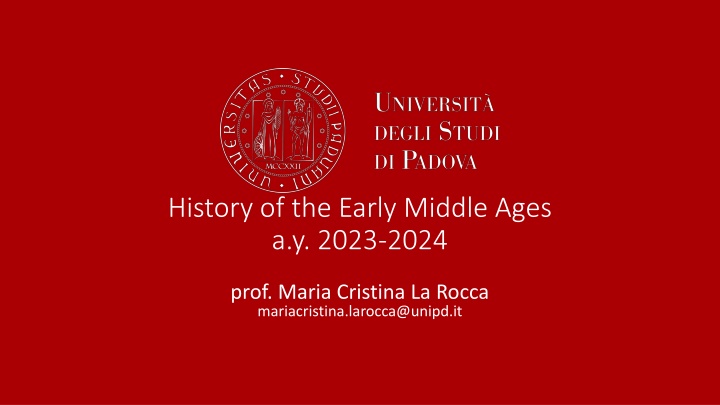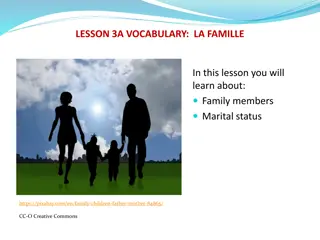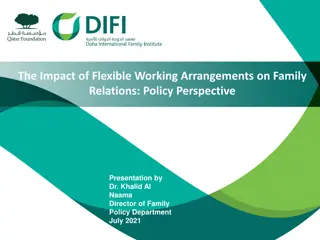
Fatherlessness in Late Antiquity: Societal Impact and Family Dynamics
Explore the phenomenon of fatherlessness in Late Antiquity, examining societal implications and family structures in Roman and late Roman contexts. Discover how patriarchal cultures and demographic factors influenced the prevalence of fatherless households, with notable examples such as the experiences of Augustine and Theodoric.
Download Presentation

Please find below an Image/Link to download the presentation.
The content on the website is provided AS IS for your information and personal use only. It may not be sold, licensed, or shared on other websites without obtaining consent from the author. If you encounter any issues during the download, it is possible that the publisher has removed the file from their server.
You are allowed to download the files provided on this website for personal or commercial use, subject to the condition that they are used lawfully. All files are the property of their respective owners.
The content on the website is provided AS IS for your information and personal use only. It may not be sold, licensed, or shared on other websites without obtaining consent from the author.
E N D
Presentation Transcript
History of the Early Middle Ages a.y. 2023-2024 prof. Maria Cristina La Rocca mariacristina.larocca@unipd.it
Extended family. Spiritual kinship Models from Social Sciences are instrumental to build up hypotheses and patterns. A more nuanced reality is testified by written sources, especially concerning exceptions. In some particular time spans, exceptions can be so relevant to modify patterns as well.
Extended family In the correspondence of Ennodius, deacon in Milan and then bishop of Pavia, at the beginning of the 6th century, many letters can be named as epistolae familiares : in them Ennodius claims to a wide number of kin, both living and dead. 1. Tenous degree of relation? 2. The problem of defining relations outside the immediate family members of the household? Examining those relationships, scholars were aware that he was explicitly vague on their nature : parentes, adfines, proximi are the most frequents elusive words in his personal missives.
Household discrepancies. Fatherless households. Richard P. Saller , Patriarchy, property and death, 1997 More than three-fift of Roman and late Romans in their twenties, more than four-fifth in their thirties, and nearly all over forty had become sui iuris for the death of their fathers. A third of Late Roman children had lost their father before reaching puberty and another third became fatherless before di age of 25 Also at birth only one child in ten had a living paternal grandfather; by the time they reach their teens the proportion diminished to one in fifty . The phenomenon of fatherless households in Late Antiquity was tied strongly to general marriage practices, resulting age differentiation in spouses, and mortality rates. Numerous examples of children growing up in households where the father was either deceased or simply absent for such extended periods of time that their children might as well have been fatherless. Nor did this appear to be a class or ethnically based situation.
The combination of a structural father- absence based in demography and the generally patriarchal culture of the ancient Mediterranean almost certainly meant that most societies would have experienced at least a limited form of fatherlessness as a phenomenon of a measureable impact on families and children.
Some famous examples Augustine (354-430) lost his father in his teenage years, was from a curial family in the provincial backwater of Thagaste in North Africa. His descriptions of his father were less than complimentary: he described Patricius as foul-tempered, uxorious, and spiritually weak. The Ostrogothic king Theodoric s (499-526) grandson and successor, Athalaric (516-534) , grew up largely under the tutelage of his mother, Amalasuntha. Epiphanius (438-496), bishop of Pavia, was an orphan from a so humble family that his normally grandiloquent biographer Ennodius passes over his origins with uncharacteristic brevity. Emperor Theodosius II s minority (born 401, Augustus 402, Emperor 408) was dominated and heavily regulated by his formidable elder sister, Pulcheria.
father surrogacy In late antiquity, when the place of Christianity grew significantly throughout the Empire and beyond, a special treatment for orphans and widows is documented. Pluralization of family structures was a key component in this broadening understanding of community responsibilities. Surrogacy could come in many forms: sometimes the role of the father was taken by a family member (often mothers); sometimes by an individual who had an obligation in some form to a minor or his family; sometimes the Church itself took responsibility for raising an orphan. Such special treatment became something not only focused upon by theologians but also institutionalized in early Christian communities.
In practical terms, however, the ability to influence and control stepchildren was not uncommon. The purpose of remarriage was often pragmatic, especially outside the aristocratic world: male protection and material support for the heirs until adulthood was reached. Although they rarely served as formal guardians, stepfathers were expected to protect their stepchildren and could play a crucial role in their security and well- being. A man of high social status could provide the connections to ensure his stepchildren s future. Stepfathers. Stepfathers (vitrici) in the Classical world in theory had few or no legal rights over their partner s children. In the unlikely event that a woman s former husband was still alive and yet their children lived with her, they would of course remain legally under his potestas. Nor would a new husband gain control of his wife s children, were she a widow. Since he possessed no blood relationship cognatic or agnatic his legal authority would be non existent.
Orphans On the other hand, having no parents did not necessarily mean a child would be left to fend for himself. Family, stepparents, or family friends might all fill the gap. The distribution of funds, i.e. in the small city of Veleia in southern Italy, indicates the scale of these projects: 50,000 sesterces were distributed to poor (citizen) children in one year alone. These public systems of support remained intact until finally ended by Diocletian in the IIIrd century. Protecting inheritances from the unscrupulous and greedy was another component of imperial care. Jurists wrote copious legislation providing protection for those minors sui iuris (under their own legal power), especially from those tutores ostensibly responsible for their wards well-being. The imperial government presumed a certain paternalism in trying to ensure that underage citizens made it to adulthood and in easing the process of succession. Romans in the imperial period did try to deal with the problems of orphaned children in creative, if not entirely successful, ways. The alimenta system set up by the second-century emperors and by a number of cities (mostly in Italy) was an open acknowledgment of the fact that the government had some responsibility to impoverished minors of the Empire.
Christian Communities, widows and orphans. Early on, this help seemed generalized in feasts (called agapai) for the whole Christian community. More concretely, the establishment of the diaconate, open initially to both men and women, was a special ministerial office created within the Church hierarchy specifically to collect and distribute alms to the poor. The Heavenly Father would fill the role of the deceased earthly father through the Church s support. An alternative and much smaller system of support and paternalism was developing in the Christian communities that increasingly dotted the cities of the Mediterranean in the second and third centuries AD. Part of this interest was reflected in the ways that Christians saw themselves as part of an adopted family: Paul had also spoken of the adoption of God through Christ. The tangible product of such an ideology was a system of material assistance in the early Church for its poorer members, with special attention for widows and orphaned children.
Orphans and charity. One of the most common components was charity that, apart from material assistance, was finding prospective adoptive or surrogate fathers. The rationale for this activity was manifold: the Christian father provided practical material support, he offered an example for his adoptee to follow, and of course he provided important moral guidance especially in religious belief. The earliest complete canons from the Council of Elvira (305 or 306) indicates that bishops ought to provide orphan boys with training in a useful trade (presumably from a Christian foster father) and to care for orphan girls until they marry (also finding suitable husbands). The responsibility for finding proper surrogate parents seems to have fallen increasingly to the Church. That widows and orphans were traditionally grouped together implies a connection between the two (orbitas could mean the state of orphanhood or widowhood). Probably parentless and fatherless could be used interchangeably, although given the demography of marriage and mortality rates, it would not be hard to conclude that orphan in the Christian context more often referred to the latter. The history of the early Church is one in which the responsibilities to orphans were loudly proclaimed.
A new phase: 4 and 5 century Specialized institutions were able to develop, including poorhouses, hospitals and orphanages. The orphanage was a clear acceptance that the idea of the Church s acting as a surrogate parent had become formalized and institutionalized. The title of orphanotrophus (the official who ran the orphanage) was interpreted specifically as a foster father. By the fourth and fifth centuries, with the recognition and patronage of Christianity by the imperial government, the notions of Christian responsibility entered a new stage. The traditional source of income for the Church voluntary giving and endowments in the form of rents - suddenly became supplemented by large land grants from both the government and an increasingly Christianized aristocracy.
Oblati: monastic household The oblatio, or the donation of an underage child to a monastery, became a common enough practice that by the sixth century Benedict had to spell out specific instructions for their care in his monastic rule. The early Church took an active and material interest in seeing to the care of its younger and often parentless members. Christians saw themselves as God s alumni, so that they became familiar with the importance of surrogacy both literally and ideally.
One example. Severinus Boethius An orphanus was the sixth-century consul, scholar and philosopher, Anicius Manlius Severinus Boethius. His father, a notable political figure in the 480s, died while Boethius was still a child (8 years old, or 12). He would grow up to play a prominent role in the Roman senate and serve king Theodoric before falling foul of some obscure political scandal (political treason) that led to his arrest and eventual execution in 524 or 525. He was raised in an aristocratic house in the city of Rome itself. The desolatum of losing his father (nothing is said about his mother, but since he was subsequently raised in a foster home, probably she was also deceased) was balanced against the blessing of being brought up in one of the most important families in Rome summi viri he defines it. The facts of his subsequent personal and public life point to the house of Q. Aurelius Memmius Symmachus. The specific nature of that relationship is unclear it may have been a formal guardianship or it could have been something more informal. As a child of the aristocracy and in fact a member of the most aristocratic of Roman gentes, the Anicii, he received a well- cared-for upbringing in the absence of his father.
Symmacus, the foster father. Boethius s rearing is described by himself as a cura, articulating once again the resonances of the legal responsibilities of a Roman tutor or curator respectively. Under Symmachus tutelage Boethius was trained for the career that he would pursue. From early on in his life, he was versed in classical literature, including rarely for this age the Greek canon. Also unusual was his interest in philosophy: in addition to his best known work, The Consolation of Philosophy (a primarily Neoplatonic exercise), he wrote a commentary on Cicero s Topica and translated Porphyry s commentary of Aristotle s Categories from Greek into Latin. Perhaps more ambitiously, Boethius planned to translate with commentary most of the Aristotelian and Platonic canon into Latin a project unrealized due to his political downfall. Like his great-grandfather of almost identical name, Symmachus was one of the leading senatorial and intellectual luminaries of his day. At some point in the second decade of the sixth century, he served as President of the Senate (caput senatus). He did engage in the sorts of extensive literary activities common among late- Roman aristocrats editing older classical works and composing a seven- book history of Rome but he also extended his classicism to devoting a significant portion of his personal wealth to building private magnificent houses in Rome and in the countryside. Significantly, he appears to have patronized important thinkers of the day.
His sponsorship of Greek speakers in Italy suggests that he saw the traditional aristocratic virtue of bilingualism as an important component of Boethius upbringing. But Greek philosophy was a somewhat unusual discipline for Westerners to pursue. Since Symmachus reputation for erudition was matched by that of his ward, it is clear that the aristocratic foster father had prepared the orphan well. Boethius literary activities not only reveal superlative training as a youth, but also the specific interests of the elder senator. This shows the potential dangers of being orphaned with specific reference to education. Without stepfathers or a strong familial support system, learning might be delayed. Symmachus seems to have been involved in Boethius education and the things he studied. Symmachus was versed in Greek and had served as Theodoric s envoy to Constantinople on at least one occasion. His erudition in Greek was in fact profound enough that the Constantinopolitan grammarian Priscian dedicated several works to him. He also was interested in philosophy, so much so that his reputation in this regard extended even to the East.
Rusticiana, Boethiuss wife and Symmacuss eldest daughter Boethius education and training led to a distinguished happy, political career. In addition to assuming traditional senatorial offices, including the consulship in 510, he was eventually made a patricius the highest possible status for a member of the imperial aristocracy. Significantly he served under king Theodoric as the highly influential magister officiorum until his arrest in 523. He had sufficient political fame that he had his two underage sons both named consul in 522. Symmachus found Boethius a suitable wife and from within his own house. As the father of at least three daughters, he gave in marriage his eldest, Rusticiana, to Boethius when they both came of age. In his semi-autobiographical work, The Consolation of Philosophy, Boethius not only expresses great respect for his wife, but the goddess Philosophy admits that his happiness has only been truly diminished by his wife s absence. As an act of filial piety, one of his two sons was christened Flavius Symmachus. Rusticiana s devotion to her husband was such that the Goths accused her many years later of desecrating statues of Theodoric in revenge for the execution of her husband and father.
A recent study, has also proposed that it was Rusticiana herself who commissioned the Dyptic of the so called Philosopher and the Muse , interpreting it as the representation of Rusticiana and her husband, to be circulated within the inner circle of their aristocratic friends, in memory of her dead husband. Boethius himself describes her in traditionally glowing terms, praising her modesty and chastity and decency. As a reflection of his gratitude, and as a measure of his praise, he goes so far as to say that Rusticiana was a female version of her father.
Many fathers did try to instill more than fear of the whip and disinheritance into their offspring. They were also advising their stepsons on property management and good behaviour. These fathers seemed to have had the best interest of their sons at heart and provided practical advice for their betterment. These examples are furthermore distinguished partially because of their concern for worldly affairs. Best interest extended to protection of sons to the best of a father s ability. In the case of Boethius, his arrest apparently sparked sufficient controversy that Theodoric feared Symmachus political opposition and Boethius seems to suggest that he was involved in trying to free his son-in-law. This was also sufficient ground to have the elderly senator arrested and subsequently put to death. Symmachus went so far as to die in order to protect his foster son and son-in-law. The suitability of the match was therefore a reflection of Symmachus duties as a foster parent and on his suitability for that role. That is best articulated by Boethius praise for Symmachus in the passage immediately preceding his discussion of his wife and children. His praise is that of a son s: Philosophy calls the elder man wise and strong and concerned for Boethius well-being, even more than his own. He also praises Symmachus for being upright morally and his closest of friends.
Conclusions. Surrogate fatherhood was conceived within the traditional rubric of fatherhood. The requirements, responsibilities, and pretensions of a real father, quite apart from any specific actions, found articulation in the words with which they were described. The rhetorical resonances of filial piety, of responsibility in the wake of loss, and the continued sense of fatherly affection and responsibility into adulthood were themes that can be traced in the stories of orphans. Halfway between a father and a guardian, the surrogate father whether as an individual or in the corporate entity of the Church was largely consistent with the traditional models of the Classical age.
REFLEXIVILITY It was the suggestion that the moral values inculcated in a child were now a part of the process of a succession. The role of Christianity rested only incidentally upon these responsibilities. Not only is there barely any discussion of Christian ideas surrounding surrogate fatherhood, but also more broadly there is little in the works of the Western patristic writers to suggest that fathers were responsible for the religious upbringing of their children. Children raised by surrogate fathers were supposed to take on the qualities and the interests of these fathers . There was an onus upon the surrogate parent to instill morals into his ward and for the child to take on those moral qualities. It is not simply that they were raised to succeed or replace their parents or surrogate parents; nor was morality per se a new component in the makeup of successful adult.






















